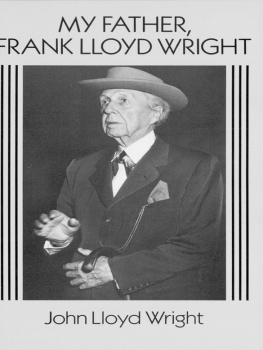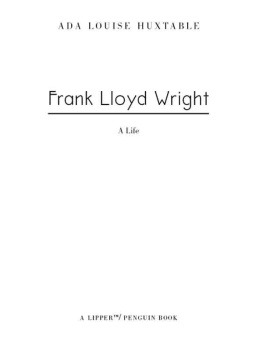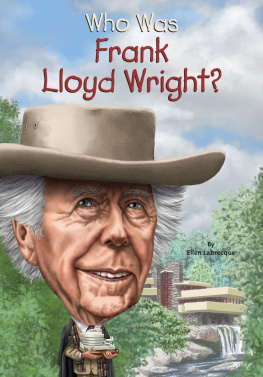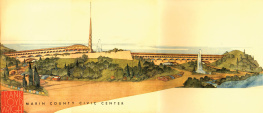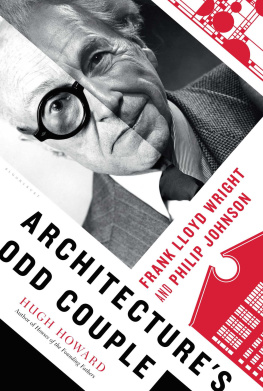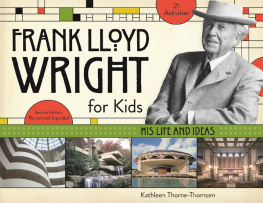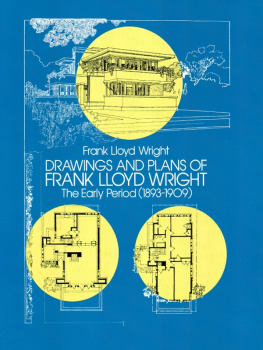
WRIGHT AND NEW YORK
WRIGHT AND NEW YORK

The Making of Americas Architect
Anthony Alofsin

Copyright 2019 by Anthony Alofsin. All rights reserved.
Drawings and letters of Frank Lloyd Wright copyright 2019 Frank Lloyd Wright Foundation,
Scottsdale, Arizona. All rights reserved.
Unless cited otherwise, letters, drawings, and photographs are located in the
Frank Lloyd Wright Foundation Archives (The Museum of Modern Art | Avery Architectural &
Fine Arts Library, Columbia University, New York)
This book may not be reproduced, in whole or in part, including
illustrations, in any form (beyond that copying permitted by Sections 107 and 108
of the U.S. Copyright Law and except by reviewers for the public press), without written
permission from the publishers.
yalebooks.com/art
Designed and set in type by Lindsey Voskowsky
Library of Congress Control Number: 2018960100
ISBN 978-0-300-23885-3
eISBN 978-0-300-24380-2
A catalogue record for this book is available from the British Library.
10 9 8 7 6 5 4 3 2 1
In memory of Bruce Brooks Pfeiffer (19302017)
Who opened the vaults of Taliesin

You can see for yourself how malignant circumstances
have buffeted this man. This giant. This ingenious giant.
The New Yorker, 1930
CONTENTS
INTRODUCTION
When you think about Frank Lloyd Wright, you think of him as the architect of the prairies and Chicago, but theres another storyWright and New Yorkthat reveals a person and a life weve never known. Between 1925 and 1932 the city turned him around, moving him from personal and professional crisis to set the stage for his final decades as the American champion of modern architecture. Fifty-eight years old, broke, harassed, and seeking refuge, he found shelter and commissions for two buildings in the citya vast modern cathedral and a new prototype for the skyscraper. They provided the context for this turnaround, freed him creatively, gave him a platform for his ideas, and, crucially, drew the attention of architects, critics, and writers.
That New York did this is ironic, as Wright loved to demonize urban life. Already in the mid-1920s he bemoaned the city as an unlivable urban nightmare run on greed. The city is a prison, he told his son Lloyd. It grated on his sensibilities and affronted him with its clamor and speed. Its fleshy excesses appalled him. He ranted against New York, a place fit for banking and not much else a crime of crimes humanity preying upon humanity carcass parasite fibrous tumor pig pile incongruous mantrap of monstrous dimensions. As we might suspect from the intensity of his protest, Wright knew New York well.
Wright was, after all, a Midwesterner born in 1867. He came from a maternal lineage of self-righteous firebrand preachers. His immediate family was fractured, as his father divorced his mother when Wright was a boy and never saw his son again. He attended a progressive rural secondary school run by his aunts, but he became a college dropout. He benefited from neither rigorous academic training nor a luxurious Grand Tour. His formation as an architect came largely through apprenticeship under his mentor, the Chicago architect Louis Sullivan. But he had innate gifts: a powerful ability to visualize in three dimensions, skill in drawing, and a critical and curious mind. He also had endless ambition and indefatigable drive. New York is where both were tested and proved.
The period from 1925 to 1932 was also crucial for modern architecture in New York, and by extension for the entire United States. New York in the 1920s not only feted the Jazz Age with its excesses and saw the emergence of fecund literature, theater, and music, but it produced marvels of Art Deco architecture. Although the style is often dismissed
In this same period, the vibrant strands of American Art Deco collided with European Functionalism, which emphasized economy, rationality, and mechanization. The saga of the New World contesting the legacy of the Old World was playing out again, specifically in a struggle to define modern architecture. Much was at stake, not only how buildings and cities would look, but American identity itself. Could the country produce an autonomous modern architecture through Art Deco, its best design expression to date? Or would it defer to the powerful seduction of Functionalism, the forerunner of the International Style? As this book shows, Wright followed the contending camps and positioned his organic architectureand his vision of Americaas the only alternative to both. The fate of this third way was up for grabs. New York is both the crucible in which the drama takes place and a player itself.
The relationship between Wright and New York is convoluted, with ups and downs, twists and turns. The story here has a few twists of its own. Writing in the 1940s, Henry-Russell Hitchcock, the leading American architectural historian and Wrights friend, promulgated a narrative about the architects influence abroad. But, he noted, it is a matter which ought to be pursued further. My first book on the
Historians had neglected the years after the golden age of Wrights Prairie period. In 1969, a decade after the architects death, theBritish architectural critic Reyner Banham observed Wrights achievement. But, Banham noted, there was an awkward passage in the chronological middle of his career that we know very little about. Banham identified Wrights Wilderness Years as the early 1910s to the early 1930s. I believe, Banham declared, that somewhere in those years he passed through some crucial experience, if not an actual crisis, that effectively separates his early career from his later work. Banham characterized the period with nuance as three wildernesses rolled into one: the professional, the spiritual, and the experience of the southwestern desert. They combined to fundamentally alter Wrights being and his career. But, as no critical history yet existed, Banham could not grasp the catalytic role New York played in Wrights transformation. Not yet clear was the interaction between city and desert that proved critical for the evolution of Wrights vision. This book makes the connection visible.
As I pursued Wright in the 1920s, I encountered some fascinating figures. The Reverend William Norman Guthrie played the role of private guide to Wrights inner world and became the client who commissioned the visionary projects for New York: the Modern Cathedral and the apartment tower for the grounds of his church, St. Marks Church in-the-Bowery. Everything about him was eccentric and idiosyncratic. Born in Scotland in 1868, Guthrie was raised on the Continent. His grandmother, the abolitionist Frances Fanny Wright, had started a utopian venture to help freed slaves in Tennessee, and the connection prompted Guthrie to study literature and theology at the University of the South in Sewanee, where he was ordained as an Episcopal minister in the late 1880s and became a lecturer and itinerant preacher. In 1911 he was appointed the rector of St. Marks and quickly set out to overhaul church liturgy. Located on East 10th Street at Second Avenue, St. Marks was one of the oldest churches in New York City, but Guthrie abandoned all of its traditions. He matched Wright in his zeal for the exotic, his devotion to primary spiritual sources, and his fierce efforts to reform not only his church but society at large. Guthrie prefigured New Age consciousness and created the milieu of what became the counterculture of the East Village. He saw in Native Americans the original spirit of America and even brought chiefs to his pulpit. He found in the Ancients, from Egypt to Greece, pure ideas and practices relevant for modern life. He sought the company of Hindu mystics and incorporated their chants into his services. And he instituted music, dramatic lighting, and rhythmic dancing by scantily clad young women as a means of spiritual elevation. Guthrie was a visionary who studied architecture, a radical who wanted to reform not just the Episcopal church but all religious practice, and a man of character who valued and nourished friendship. Wright found in him an ideal confidante, friend, and client. Their relationship is one of the great unsung connections between artist and patron in the history of modern art.
Next page


